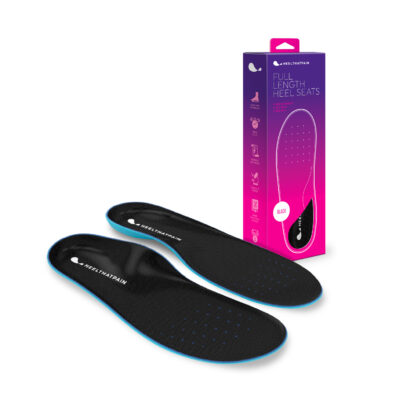Chronic foot pain and discomfort could mean that your feet aren’t getting the level of support they need. Replacing your shoes’ standard insoles with a supportive or corrective insert is a possible solution. Two of the main insole-replacement options are shoe inserts, which you can purchase over-the-counter, and orthotic inserts, which are prescribed by a doctor.
What are orthotic inserts?
Orthotics are shoe inserts that either replace your insoles with something more supportive or that add support to your existing insoles.
Over-the-counter orthotic inserts
Over-the-counter orthotic inserts are available in many different configurations and materials. They can provide extra cushioning for your heels, toes, or your whole foot, and they come in a variety of firmness options depending on your needs. They typically cost between $20-$80 and can be purchased without a prescription.
Prescription orthotic inserts
Prescription orthotic inserts are custom-made and prescribed by a doctor. If an over-the-counter option hasn’t proven effective, podiatrists might prescribe custom orthotics to correct issues in how people stand, walk, and/or run. Prescription orthotics are more expensive than over-the-counter options, often in the $200-$800 price range or more.
Orthotic devices can be used to address a number of health concerns. According to Healthline, orthotics might serve as part of a treatment plan for heel or foot pain, leg pain, back pain, plantar fasciitis, arthritis, diabetic neuropathy, heel spurs, prior injuries (such as sports injuries), bunions, and more. Sometimes, orthotics are used as a preventative measure to help avoid future injuries, such as for individuals with high arches or flat feet that affect their gait.
Shop our clinically proven orthotics
-
 High Arch Sole Seats$39.95
High Arch Sole Seats$39.95 -
 HTP Heel Seats (Pair)$24.95
HTP Heel Seats (Pair)$24.95
Orthotics for heel pain
Heel pain has many causes. According to the American Podiatric Medical Association, sources of heel pain include abnormalities in gait, sports injuries, plantar fasciitis, heel spurs, and flimsy/unsupportive footwear.
Many treatments for heel pain involve making better footwear choices: opting for well-fitting and supportive shoes, choosing activity-appropriate shoes, and not wearing shoes with an excessive heel or sole wear. However, most shoes don’t come with supportive insoles, which is why adding orthotics might help. Depending on the material and shape of the orthotics you choose, they can support your arch, cushion your feet, absorb shock, or help correct a faulty gait — all of which can provide relief and promote healing.
There are a few types of over-the-counter orthotics to choose from if you have heel pain. Heel Seats are appropriate for people with average arches (not too high or too low) who need added support in their footwear. If you have high arches, opting for Full Length Heel Seats With Arch Support will support both your heel and your arch simultaneously. Gel Heel Seats are soft and shock-absorbent, making them suitable for those with sensitive feet and those who have never worn orthotics before.
Orthotics for heel spurs
Another common cause of heel pain is heel spurs, which are bony protrusions on the underside of the heel bone caused by stress on foot muscles and ligaments. Similar to plantar fasciitis, they can be caused by multiple factors including flat feet, high arches, an atypical gait, running and jogging, obesity, and wearing soft or unsupportive footwear.
Shoe inserts and orthotics like Heel Seats are a primary non-medical treatment recommendation for heel spurs. They can help by absorbing shock, thereby reducing the pain that occurs when walking or standing. They also cushion the foot, relieving pressure and reducing friction when you walk, thus promoting non-surgical recovery. Best of all, Heel Seats are the only orthotic inserts on the market with Fascia Bar Technology, which is clinically proven to be effective for heel spurs. Inserts that provide cushioning are a dime a dozen, but the Fascia Bar works differently by gently lifting and realigning the plantar fascia ligament, to relieve pressure on the area affected by the heel spur and target the root cause of the problem.
Orthotic inserts for runners
Running is a primary cause of orthopedic pain and discomfort due to the strain it puts on your feet. If you aren’t wearing supportive shoes or if you have an unnatural gait, flat feet, or high arches, you can end up with plantar fasciitis, heel spurs, stress fractures, or other orthopedic health issues.
Orthotics are beneficial for runners because they promote a healthy stride and reduce impact. Quality orthotics also perform the important function of supporting your fascia during the strain of impact, and they can be used both to prevent running injuries and to treat them. When you’re shopping for running orthotics, you should make sure you pick an option that won’t slide around in your shoe. For this purpose, a full-length orthotic is preferable. Additionally, make sure your orthotics are suited to your foot shape, especially if you have high arches or flat feet.
Are prescription orthotics better than over-the-counter shoe inserts?
Over-the-counter orthotics offer an accessible, affordable option for better support and better-distributed pressure for your feet. There are many different shapes, sizes, and materials available, so it’s likely that you’ll be able to find something to meet your needs. However, because they’re not specially designed for your foot, over-the-counter orthotic devices may not be able to make significant corrections to your gait or correct severe biomechanical issues.
On the other hand, prescription orthotics are custom-made to precisely fit the contours of your foot, meaning they can be designed to correct abnormal motion or address other noteworthy concerns — but that comes at a steep price. While there are pros and cons of both prescription and over-the-counter orthotics, research has shown that prescription orthotics aren’t necessarily more effective than over-the-counter options.
So whether you’re currently experiencing foot pain or you want to be proactive to prevent future injuries, orthotic inserts can keep your feet feeling comfortable and supported. And you don’t have to break the bank in order to find relief; a high-quality over-the-counter orthotic will often do the trick.



